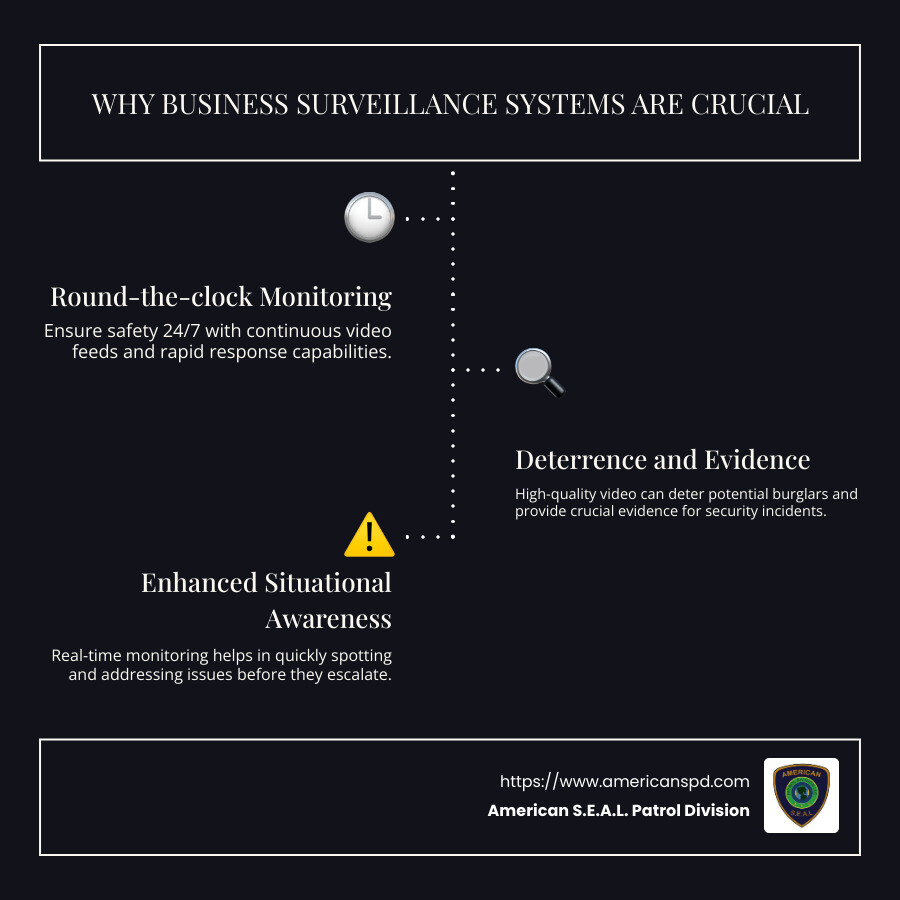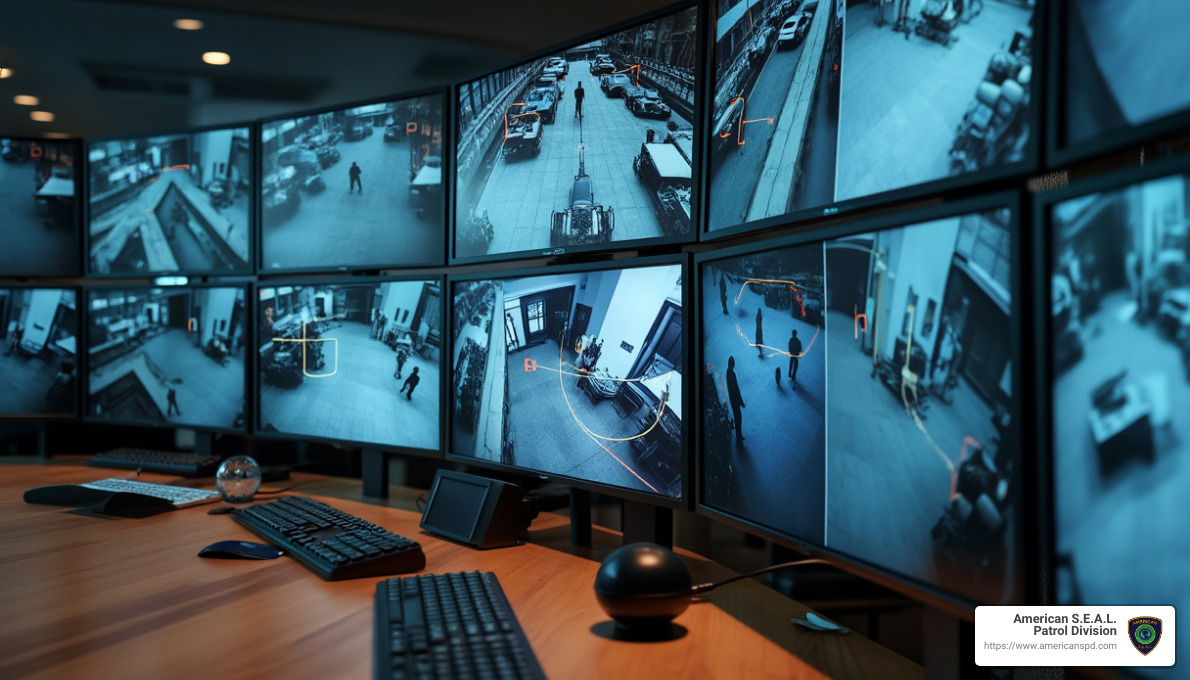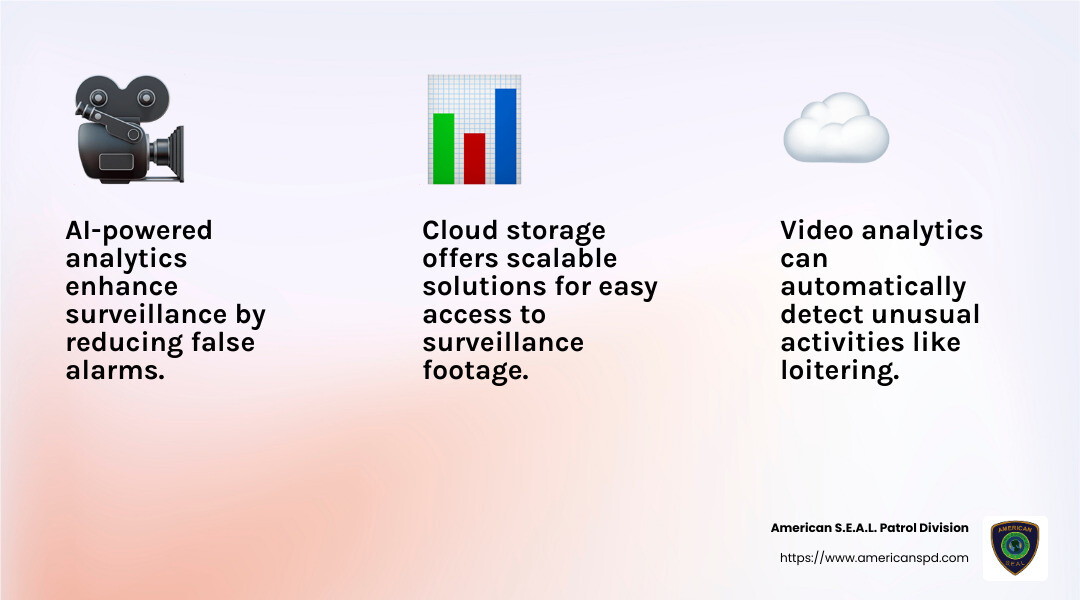Business surveillance camera systems are essential tools for any business, large or small. Today, investing in these systems is not just about protection, but about gaining peace of mind and boosting operational efficiency. If you’re a busy property manager, like Sarah Thompson, you need to ensure safety across multiple locations. Here’s a quick look at why business surveillance systems are crucial:
- Round-the-clock Monitoring: Ensure safety 24/7 with continuous video feeds and rapid response capabilities.
- Deterrence and Evidence: High-quality video can deter potential burglars and provide crucial evidence for security incidents.
- Improved Situational Awareness: Real-time monitoring helps in quickly spotting and addressing issues before they escalate.
- Advanced Technology: AI-powered video analytics and smart notification systems keep you informed about potential threats.
These systems are indispensable in helping businesses deter crime, manage risk, and ensure a secure environment. Whether it’s through traditional CCTV or modern digital solutions like IP cameras, the choice of surveillance technology can significantly impact your security strategy.
Understanding Business Surveillance Camera Systems
When diving into business surveillance camera systems, it’s important to understand the different types of systems available: NVR systems, DVR systems, IP cameras, and analog cameras. Each plays a unique role in how video surveillance is captured, processed, and stored.
NVR Systems
Network Video Recorder (NVR) systems are at the forefront of modern surveillance technology. They use digital IP cameras to capture video and audio, processing these signals before sending them to the recorder. This digital approach offers several advantages:
- Higher Resolution: IP cameras provide clearer, high-resolution images compared to their analog counterparts.
- Advanced Features: Many NVR systems include features like face recognition and person/vehicle detection.
- Flexibility: NVR systems can be wired via Ethernet cables or use wireless connections, offering flexibility in installation.
These systems are ideal for businesses looking to integrate advanced technology into their security setup.
DVR Systems
Digital Video Recorder (DVR) systems represent a more traditional approach to surveillance. They use analog cameras, which are connected to the recorder through coaxial cables. Here are some key points about DVR systems:
- Reliable Connection: The use of coaxial cables ensures a stable connection.
- Cost-Effective: Generally, DVR systems are less expensive than NVR systems, making them a viable option for small businesses.
- Basic Functionality: While they may lack some of the advanced features of NVR systems, they still provide reliable video recording.
DVR systems are perfect for businesses looking for a straightforward, cost-effective surveillance solution.
IP Cameras vs. Analog Cameras
IP Cameras are digital cameras that offer high-resolution video and advanced features like motion detection and remote access. They are a staple in NVR systems and are known for:
- Scalability: Easily add more cameras to the network as needed.
- Remote Monitoring: Access live feeds from anywhere using mobile apps or web interfaces.
Analog Cameras, used in DVR systems, are more traditional and provide basic video surveillance. They are:
- Simple to Use: Easy to set up with existing coaxial cable infrastructure.
- Budget-Friendly: Typically less expensive than IP cameras.
In summary, the choice between NVR and DVR systems, as well as IP and analog cameras, depends on your business needs and budget. Understanding these options will help you make an informed decision about your surveillance strategy.
Key Features of Business Surveillance Systems
When choosing business surveillance camera systems, it’s crucial to focus on the key features that can improve security and operational efficiency. Here are the top features to consider:
Video Analytics
Video analytics transform how businesses handle surveillance. This feature uses algorithms to analyze video footage in real-time, identifying specific patterns or behaviors. For example, businesses can set up alerts for unusual activities like loitering or unauthorized access. This proactive approach allows security teams to respond quickly to potential threats.
Remote Monitoring
Remote monitoring is a game-changer for businesses. It allows you to keep an eye on your premises from anywhere, at any time. Using mobile apps or web interfaces, business owners and security personnel can access live feeds and recorded footage. This feature is especially beneficial for businesses with multiple locations or for managers who travel frequently.
Storage Capabilities
Storage is an essential aspect of any surveillance system. Businesses must decide between on-premise storage and cloud storage. On-premise options often involve local hard drives, offering control over data but requiring maintenance. Cloud storage, on the other hand, provides scalable solutions with easy access to footage, though it may involve ongoing subscription costs.
- On-Premise Storage: Ideal for businesses needing control over their data.
- Cloud Storage: Offers flexibility and scalability, perfect for businesses looking for hassle-free storage solutions.
AI-Powered Analytics
AI-powered analytics take video surveillance to the next level. These systems use artificial intelligence to detect and analyze patterns, offering features like facial recognition and object detection. AI can differentiate between a person and a vehicle, reducing false alarms and providing more accurate data.
Incorporating AI into your surveillance system can significantly boost situational awareness and decision-making efficiency. This technology allows businesses to automate monitoring tasks, freeing up human resources for other critical functions.
By focusing on these key features, businesses can create a robust surveillance system custom to their specific needs. This ensures not only improved security but also improved operational efficiency, making it a worthwhile investment.
Next, we’ll explore the different types of cameras available for business surveillance systems, helping you choose the right ones for your setup.
Types of Business Surveillance Cameras
Choosing the right types of cameras is crucial for business surveillance camera systems. Different cameras serve different purposes, and understanding their unique features can help you make informed decisions.
Dome Cameras
Dome cameras are popular for their sleek design and versatility. These cameras are typically mounted on ceilings and are encased in a dome-shaped housing. This design makes it difficult for onlookers to determine which direction the camera is pointing.
- Advantages: Dome cameras are discreet and vandal-proof, making them ideal for areas that require subtle surveillance, like lobbies and reception areas.
- Installation: They can be used indoors or outdoors, providing flexibility in placement.
Bullet Cameras
Bullet cameras are easy to recognize due to their long, cylindrical shape. They are typically mounted on walls and are excellent for capturing images over long distances.
- Advantages: Bullet cameras are weatherproof and have a long-range focus. They are ideal for outdoor use, such as monitoring parking lots or building exteriors.
- Features: Many bullet cameras come with infrared capabilities, allowing for clear images even in low-light conditions.
PTZ Cameras
PTZ (Pan-Tilt-Zoom) cameras offer dynamic surveillance capabilities. As the name suggests, these cameras can pan, tilt, and zoom, providing wide coverage and detailed monitoring.
- Advantages: PTZ cameras allow operators to control the camera’s movement remotely, making them perfect for monitoring large areas like warehouses or expansive office floors.
- Special Features: With powerful zoom capabilities, PTZ cameras can focus on specific details or track moving objects, providing comprehensive surveillance.
360-Degree Cameras
360-degree cameras provide all-around visibility from a single vantage point. These cameras are equipped with fisheye lenses that capture a full panoramic view.
- Advantages: Ideal for monitoring open spaces such as retail floors or large office areas. They reduce the need for multiple cameras, saving costs.
- Installation: These cameras are usually mounted on ceilings and offer unobtrusive surveillance, making them a favorite for customer-facing environments.
By understanding the specific benefits and uses of each camera type, businesses can tailor their surveillance systems to meet their unique needs. Whether you require discreet indoor monitoring or robust outdoor coverage, there’s a camera designed to meet your requirements.
Next, we’ll dig into the benefits of implementing business surveillance systems and how they can improve security and operational efficiency.
Benefits of Implementing Business Surveillance Systems
Implementing business surveillance camera systems offers a range of benefits that go beyond just keeping an eye on things. Let’s explore how these systems can improve your business through deterrence, operational efficiency, and situational awareness.
Deterrence
One of the most powerful aspects of surveillance systems is their ability to deter crime. Just the sight of a camera can make potential wrongdoers think twice. According to research, businesses, especially retail stores, lose thousands every minute to theft. However, the presence of cameras can significantly reduce these losses by discouraging shoplifters and dishonest employees.
- Visible Cameras: Placing cameras in visible locations can prevent theft and vandalism. When people know they’re being watched, they’re less likely to engage in illegal activities.
- Recorded Evidence: Should an incident occur, having video footage can help in investigations and legal proceedings, ensuring justice is served.
Operational Efficiency
Surveillance systems aren’t just about security; they’re also about improving how your business operates. By keeping an eye on daily activities, businesses can identify inefficiencies and streamline operations.
- Process Monitoring: Cameras can help spot bottlenecks in processes, whether in manufacturing lines or customer service areas. This allows management to make data-driven decisions to improve productivity.
- Safety Compliance: In industries like oil and gas, surveillance can ensure safety protocols are followed, reducing the risk of accidents and improving overall safety.
Situational Awareness
Having a comprehensive view of your business environment is crucial. Surveillance systems provide real-time insights into what’s happening across your premises.
- Remote Monitoring: With modern systems, you can monitor your business from anywhere, at any time, using mobile apps. This flexibility ensures you’re always in the loop, even when you’re not physically present.
- Smart Alerts: Advanced systems come with features like motion detection and AI-powered analytics. These tools can alert you to unusual activities, allowing for swift responses to potential threats.
Incorporating a business surveillance camera system is not just about security; it’s about creating a more efficient, safe, and aware business environment. Whether it’s deterring crime, improving operations, or enhancing situational awareness, the benefits are clear and impactful.
Next, we’ll tackle some frequently asked questions about these systems, helping you understand costs, differences between surveillance and security cameras, and employee monitoring considerations.
Frequently Asked Questions about Business Surveillance Camera Systems
How much does it cost to install a security camera for a business?
The cost of installing security cameras for a business can vary widely based on several factors. For small businesses, a simple DIY setup might be more cost-effective. However, larger businesses with complex needs often require professional installation, which can be more expensive.
- Basic Systems: These can start at a few hundred dollars for simple setups with a couple of cameras.
- Advanced Systems: For larger commercial systems with multiple cameras, storage solutions, and advanced features like AI analytics, costs can rise into the thousands.
While upfront costs are important, consider ongoing expenses like maintenance and potential subscription fees for cloud storage or advanced analytics.
What’s the difference between surveillance cameras and security cameras?
Though often used interchangeably, surveillance cameras and security cameras serve slightly different purposes.
-
Surveillance Cameras: These are typically used for continuous monitoring, often in public or high-traffic areas. They are designed to capture footage over a large area and are often part of a broader surveillance system.
-
Security Cameras: These are usually part of a security system, designed to detect and alert for specific events, like unauthorized entry. They often work in conjunction with alarms and other security measures.
Both types can be integrated into a comprehensive business surveillance camera system to provide layered security and monitoring.
Can surveillance cameras be used to check employees?
Yes, surveillance cameras can be used for employee monitoring, but there are important considerations to keep in mind.
-
Monitoring for Safety and Efficiency: Cameras can ensure employees follow safety protocols and help identify workflow inefficiencies. This is especially useful in industries like manufacturing and retail.
-
Misconduct Investigation: Cameras can provide evidence in cases of employee misconduct, such as theft or harassment. However, it’s crucial to balance monitoring with privacy considerations.
It’s important to communicate clearly with employees about the presence and purpose of cameras to maintain trust and comply with legal regulations.
Understanding these aspects of business surveillance camera systems can help you make informed decisions about implementing the right solution for your business needs.
Conclusion
At American S.E.A.L. Patrol Division, we understand the critical role that business surveillance camera systems play in ensuring the safety and security of your business. Our expertise in security services, honed over 15 years in Texas, allows us to offer custom solutions that meet the unique needs of each client.
We combine cutting-edge technology with expert personnel to deliver 24/7 monitoring and rapid response. This approach not only improves security but also provides peace of mind, knowing that your business is protected around the clock.
Whether you’re looking to deter potential threats, improve operational efficiency, or improve situational awareness, our business surveillance systems can help achieve your goals. By integrating advanced features like AI-powered analytics and remote monitoring, we ensure that you have the tools needed to keep your business safe.
If you’re ready to take your business’s security to the next level, we invite you to explore our CCTV Monitoring Services. Let us be your trusted partner in safeguarding what matters most to you.





